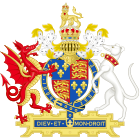Bridges Act 1530
 From Wikipedia the free encyclopedia
From Wikipedia the free encyclopedia
| Act of Parliament | |
 | |
| Long title | An Acte concernyng the amendement of Bridges in Highe Wayes.[2] |
|---|---|
| Citation | 22 Hen. 8. c. 5 |
| Territorial extent | Kingdom of England |
| Dates | |
| Royal assent | 31 March 1531 |
| Other legislation | |
| Repealed by | |
Status: Repealed | |
The Bridges Act 1530[1] (22 Hen. 8. c. 5), sometimes called the Statute of Bridges,[3] was an act of the Parliament of England.
It was passed in 1531. It was intended to ensure the upkeep of bridges, which at the time were usually made of wood and required regular maintenance in order to keep them open.
Section 3 ceased to have effect by virtue of section 311 of, and Schedule 23 to, the Highways Act 1959 (7 & 8 Eliz. 2. c. 25).[4] The whole Act was repealed by section 312(2) of, and Schedule 25 to, the Highways Act 1959 (except as it related to non-trunk roads in Greater London). The repeal effected by section 312(2) of the Highways Act 1959 was extended to Greater London by section 16(2) of, and paragraph 70 of schedule 6 to, the London Government Act 1963.
Section 1
[edit]In this section, the words "whereof one to be of the quorum" were repealed by section 1 of, and Schedule 1 to, the Statute Law Revision Act 1948.
Section I empowered justices of the peace to look into matters of broken bridges and to arrange for their repair or rebuilding by, or at the expense of, those who were responsible for their maintenance.
Section 2
[edit]Under section II, in cases where those responsible could not be determined, the burden would fall on the inhabitants of the city or town the bridge was situated in; if it lay outside a town, then the burden would fall on the shire or riding as a whole.
Section 3
[edit]In this section, the words "or iiii of the said justices at the leaste whereof one to be of the quorum", the words from "to call before them the constables" to "inhabitauntes shall have power and auctoritie", and the words from "and after such taxacion made" to "delyver to the owner thereof" were repealed by section 1 of, and Schedule 1 to, the Statute Law Revision Act 1948.
Section III provided that in these cases, the justices of the peace were empowered to call before them the constables of every town and parish in the area responsible – in the absence of the constables, "two of the most honest inhabitants" would suffice – and, with their assent, assess and then tax every inhabitant for a reasonable sum to cover the cost of the work required. The justices were to draw up a roll of all persons so taxed, and appoint two collectors in every hundred. The justices were also given the power to appoint two surveyors to oversee the work, who would receive the money from the collectors.
Section 7
[edit]In this section, the words "whereof one to be of the quorum" were repealed by section 1 of, and schedule 1 to, the Statute Law Revision Act 1948.
Bridges Act 1803
[edit]| Act of Parliament | |
 | |
| Long title | An Act for remedying certain Defects in the Laws relative to the building and repairing of County Bridges, and other Works maintained at the Expense of the Inhabitants of Counties in England. |
|---|---|
| Citation | 43 Geo. 3. c. 59 |
| Territorial extent | England |
| Dates | |
| Royal assent | 24 June 1503 |
| Other legislation | |
| Amended by | Criminal Law Act 1826 |
| Repealed by | Highways Act 1959 |
| Relates to | Plymouth Corporation Act 1923 |
Status: Repealed | |
| Text of statute as originally enacted | |
The Bridges Act 1803 (43 Geo. 3. c. 59) created some additional statutory provisions that had become necessary due to the effluence of time and events since the 1530 Act. This included giving statutory weight to the common law title of the key technical officials engaged for these functions by the Crown, namely, the county surveyor of the county responsible for the upkeep of subject bridges, and the roads over them for 100 yards past the ends of the bridge.[5]
See also
[edit]References
[edit]- ^ a b The citation of this Act by this short title was authorised by section 5 of, and Schedule 2 to, the Statute Law Revision Act 1948. Due to the repeal of those provisions, it is now authorised by section 19(2) of the Interpretation Act 1978.
- ^ These words are printed against this Act in the second column of Schedule 2 to the Statute Law Revision Act 1948, which is headed "Title".
- ^ R v Mashiter (1837) 6 Adolphus and Ellis 153. Reprinted in Reports of Cases argued and determined in the English Courts of Common Law. T & J W Johnson. Philadelphia. 1839. Volume 33. Page 34.
- ^ "Highways Act 1959" (PDF).
- ^ The Statutes of the United Kingdom of Great Britain and Ireland. Vol. 19.
Other reading
[edit]- Tudor Constitutional Documents, AD 1485-1603, by J.R. Tanner. Cambridge University Press, 1951. p. 495.